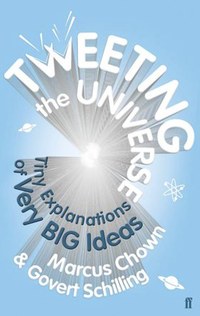Review: Tweeting the Universeby Jeff Foust
|
| If you’re not familiar with Twitter, the writing style in the book can be a little jarring. With only 140 characters, there’s no room for flowery prose or long-winded explanations. |
Chown and Schilling cover a lot of ground in the book, starting with the Earth and working their way out into the universe. Each chapter answers a fairly basic question: Why is the sky blue? How do we know the age of the Earth? What is dark energy? They then answer that question in the series of “tweets”, usually 10 to 12 per chapter. (To help promote the book, the authors have published several sample chapters as actual tweets from their Twitter accounts.)
If you’re not familiar with Twitter, the writing style in the book can be a little jarring. With only 140 characters, there’s no room for flowery prose or long-winded explanations. While brevity may be the soul of wit, at times it can appear to be too brief: sometimes the sentences appear like exercises in note-taking, with articles like “a” and “the” dropped. An example is this “tweet” from a chapter on solar flares: “Solar flares decrease lifetime of artificial satellites, by heating up/expanding upper atmosphere, so creating drag on orbiting bodies.” The meaning is clear, but the writing style is something that ordinarily wouldn’t pass muster. To their credit, they don’t go to the greater lengths that others on Twitter do in terms extensive use of abbreviations or even the shorthand common in text messaging.
That said, Chown and Schilling have done a fine job condensing the universe into bite-sized morsels of text. However, this effort prompts the question: who is the ultimate audience for this book? Has the Internet, as Nicholas Carr suggested in his 2010 book The Shallows: What the Internet is Doing to Our Brains, so shortened some individuals’ attention spans that they need information atomized to this level because they lack the ability to concentrate enough to read a longer book? (And, if so, would they even buy a book?) On the other hand, limits, even arbitrary ones, can stimulate creativity: would the recent film The Artist be so critically acclaimed if it had told the same story with dialogue and color? What the book does demonstrate is that it is possible to answer some of the key questions about our universe in a concise manner—one that, hopefully, encourages readers to look for more details in sources not constrained by a 140-character limitation.
